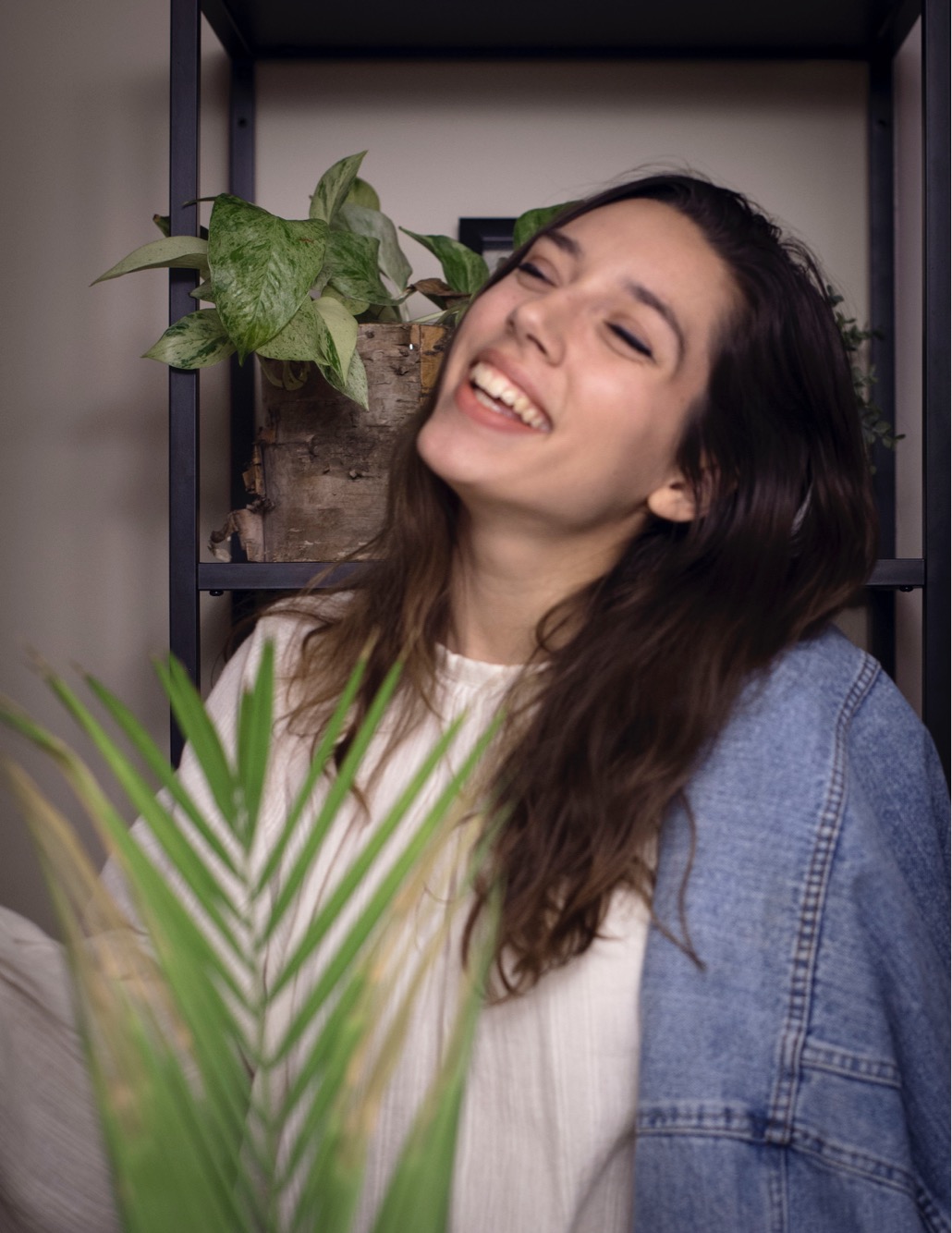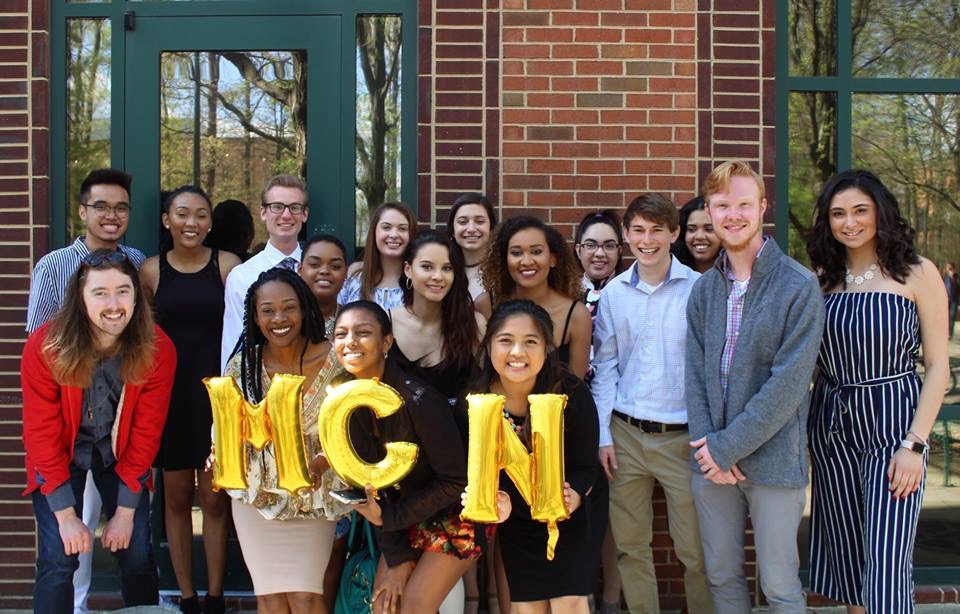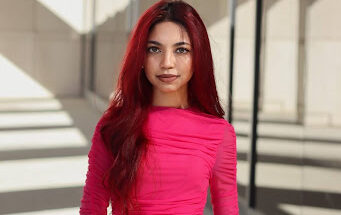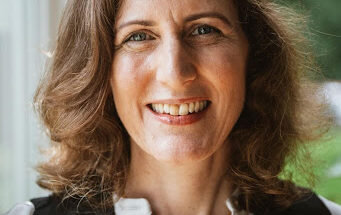HAILEY BULLIS, ASSISTANT CULTURE EDITOR
Student: Katana Lippart
HOW DID YOU GET INTO ART?
I started in high school doing art classes, just sort of as an elective. Then in community college, I was exploring it a little bit more as a career option, and then when I transferred to George Mason I was, you know, much more confident and set that I wanted to do art.
WHAT MEDIA DID YOU START WORKING WITH?
Definitely drawing, either from life or from looking at some of the masters’ works and experimenting with that, but then also painting. So, I don’t know; it’s kind of funny, because I don’t really do either of those anymore. Now I’m mostly into collage and printmaking.
HOW DID YOU GET INTO COLLAGE AND PRINTMAKING?
Collage sort of originated out of daydreaming and the fact that I couldn’t draw what I was envisioning. In order for me to do that, I would just compile different images, and then printmaking originated when I was at a community college. One of the professors there, Michael Dean, is a printmaker and sculptor, and he was explaining the printmaking process, and I absolutely fell in love with it. Especially with working in layers, where only one color equals one layer, it really transforms the piece. You really don’t know what you’re working with, or you think you know what you’re working with, but then that last layer really surprises you every time.
WHAT ARE YOU WORKING ON NOW?
Definitely, I am actually graduating this December, so I’m working on my capstone right now, and I’ll be in the senior art show [on] Dec. 14, and a lot of the work that I’ve been doing recently has been sort of looking at themes of home—defining what home means and memory. In those projects I’ve been reevaluating what that looks like and what that feels like. And so I’ve kind of set it in an alternative ’60s era, because printmaking and collage both sort of originated as fine-art forms during that period. I’m kind of relating it back historically, but then also sort of just like this super nostalgic feel for something that I have lost or something that I maybe never had to the extent that I felt before. It’s been definitely a lot of researching of art installation and a lot of historical context to make sure I get things the way I want, but I’m happy with how it’s coming along.
Faculty: Ted Kinnaman
WHAT DO YOU TEACH AT MASON?
Well, I teach philosophy. I teach mostly courses in the history of philosophy, especially what we call modern philosophy, which is 17th and 18th century. So I teach Descartes, Kant, Hume and people like that.
WHAT DREW YOU TO TEACHING THOSE PARTS OF PHILOSOPHY?
I had a course on modern philosophy when I was in college, and it was the most exciting course I took as an undergraduate. The course I teach today is not that different than the course I took in college.
Every philosophy department in the country requires a modern philosophy course, a 17th- and 18th-century course, and it requires you to teach Descartes and Hume and Kant.
The course I had was just a great course. I had a chance not too long ago to see the guy I took it with and thank him and tell him I think of him all the time when I teach the course, ’cause he really inspired me.
WHAT GAVE YOU THE OPPORTUNITY TO SEE YOUR OLD PROFESSOR?
College reunion.
WHAT IS ONE OF THE MOST INTERESTING THINGS YOU’VE EVER DONE?
I’ve lived in Germany. I’ve worked on a cattle ranch in Montana.
WHAT BROUGHT YOU TO GERMANY?
Well, I studied German philosophy, and I studied the German philosopher Immanuel Kant. So I’ve been to Germany [and] studied the philosophers there.
WHAT ABOUT THE CATTLE RANCH IN MONTANA?
The cattle ranch was just a job. It was a guy who was an alum, an alum of my college, who after [graduation] from college, he bought a cattle ranch, and then he would hire people from our college. It was just a summer, but it was a summer out in the open prairie of Montana, irrigating the fields and moving cattle around and running into the occasional rattlesnake. It was just a brief little interlude for me, not a life.
SO WHAT’S A HOBBY OF YOURS OTHER THAN PHILOSOPHY?
I kind of have a hobby in beer. I used to brew beer, though it’s been a while since I brewed a batch of beer. I like really good beer and tasting different kinds of beer. I grew up in Wisconsin, where everybody drinks beer, and so I grew up kind of loving beer. Compared to when I was younger, I drank a lot less beer, so I can drink more expensive and nicer beers now. And that’s what I do. I sort of try different varieties and compare different beers.
WHAT WAS THE FIRST TIME YOU TRIED TO BREW BEER LIKE?
The first time I brewed beer, I was in graduate school and it was surprisingly easy, because I just followed a recipe in a book. There [are] fast ways of brewing beer and easy ways of brewing beer—not-fast ways—and I did it not the fast way. I did a more difficult way for better beer. And I got great beer. My first batch was really, really good. It was an India pale ale.
I often tell my students, actually. … I could explain more about why it’s relevant in a philosophy class. I tell my students that the first batch—I don’t tell them it was the first batch I brewed—but I tell them the beer I brewed, I took it to a beer judge.
I was in a beer club and there was a guy who was a professional beer judge. He tasted my beer, and he had never met me, and … I didn’t tell him anything about the beer, and he said, “Aha, you used liquid yeast.” And I had. I used liquid yeast, and he was able to detect that just on the basis of one sip, which is pretty remarkable when you think about it. But that was my very first batch of beer, a very long time ago.
WHY IS IT RELEVANT TO A PHILOSOPHY COURSE?
Because … there’s an argument that a number of philosophers use called “the argument from the relativity of perception.” The argument is roughly that if people perceive different things with their senses, then that is reason for skepticism about whether they’re perceiving the same thing.
So, if you might taste my beer, and you would not be able to taste that there was liquid yeast. There must be some taste in the beer that makes it the taste of liquid yeast. If you’re not a liquid expert, you wouldn’t be able to taste it. But he was able to taste it, supposedly, and it’s supposedly the same beer, but he tasted something different in it.
How things are perceived is relative to the perceiver. And so the conclusion that gets drawn is that a property like taste exists only in relation to a perceiver. It’s not something that’s in the beer itself.
WHAT WOULD YOU SAY IS YOUR BIGGEST STRENGTH?
I think I can be empathetic.
OTHER THAN GERMANY, HAVE YOU EVER TRAVELED ANYWHERE ELSE?
I have. Mostly to Europe. I’ve traveled [to] a bunch of places in the United States. I’ve been to Italy a few times. I’ve been to France a couple of times. I’ve been to England and Russia and Brazil. I’ve been to Liechtenstein and the Vatican, and—I’m trying to think of other small places—Luxembourg and Poland and Hungary. So I’ve been to a bunch of different places.
What would you say is your favorite place to travel to?
Rome. … It’s an ancient city that all of Western civilization is really built on. You know, you walk around there, and you just see so many things that are part of Western [civilization] from way back, from more than 2,000 years ago.
You can go around and walk around and see stuff like this, and then you go to restaurants, and there’s fantastically good food. I’ve only been to Rome once, but I was there for over a week, and that [was] what we did every day. We went out and saw amazing things during the day, and we had delicious, huge and wonderful meals with red wine at night, and I could do that forever.
Organization: Mason Cable Network
WHAT IS MASON CABLE NETWORK? WHAT TOPICS DO YOU GUYS COVER?
Angelique Arintok, General Manager: Mason Cable Network (MCN) is the student-operated television station on campus. We run our shows on campus channel 8.1, masoncablenetwork.com and youtube.com/masoncablenetwork. Our content is completely crafted by the students for the students. We have shows that range from sports [to] news to entertainment.
CAN YOU NAME AND DESCRIBE SOME OF YOUR SHOWS?
Like I said, the shows we have on the network consist of a really mixed bag. Our shows really portray the passion of their student creators. For example, Erin Whitton and Ryan Donohoe are both seniors with a strong liking for baseball—so much so that they host a twice-monthly baseball talk show called “Touch Base.” We run a live weekly news broadcast for Mason Cable News and also have fun entertainment programs like “What’s Up, Mason?” led [by] Braxton Bonner and “Mason Munchies,” hosted by junior communication major Reagan Ortiz.
WHAT IS THE DIFFERENCE BETWEEN MASON CABLE NETWORK AND MASON CABLE NEWS?
Mason Cable Network is the umbrella for all our programs, and “Mason Cable News” happens to be one of those programs. The news team dedicates their time [to] providing students with the latest news, and also features relevant events happening on campus. Over the last semester, we’ve had the chance to cover Suit Up, Mason!, Comedy Circuit with America’s Got Talent finalist Sam Comroe and the Virginia Senate debate.
WHAT IS YOUR MOST POPULAR SHOW?
It’s tough to really say which show is the most popular, since each has its own following, given the wide range of genres we offer. But, across the board—the “Mason Cable Night Show with Cody Borden” has got to be the most viewed this semester. Cody, a junior communication major at Mason, is truly a star on the rise. His ultimate dream is to host his own late-night show, much like Jimmy Fallon and Stephen Colbert. I’m glad we’re able to offer Mason Cable Network as a platform for him to practice anything and everything, behind and in front of the camera.
IS THERE A SHOW THAT HAS BECOME A STAFF FAVORITE TO SHOOT?
We have one main team member who coordinates all the shooting for our (about) 10 student programs on the network, sophomore communication major Cruz Sanchez. Knowing Cruz, I have learned that he enjoys a good challenge when it comes to video. So, in that aspect, the “Mason Cable Night Show” has given him a lot of unique situations this semester, [from] a GoPro setup for walking through a haunted house [to] sliding through ice with no skates to capture Cody with the Mason Club Ice Hockey team. But, on a more regular basis, his favorite to shoot is probably “What’s Up, Mason?” where he and the host, Brax, face a lot of rejection with their man-on-[the]-street filming operation. Oftentimes, the rejection is comedic, which makes for some funny outtakes and moments.
WHAT CAN VIEWERS EXPECT TO SEE FROM YOU GUYS NEXT SEMESTER?
Viewers can expect to see more content on the network next semester. This fall, MCN had a lot of new volunteers involved from areas in news to sports broadcasting. So, I really believe that they’ll effectively use what they learned this semester to implement a wider variety of content in 2019.
HOW CAN PROSPECTIVE STUDENTS GET INVOLVED?
We welcome any and all students who have a passion for television production. They can get involved by emailing mcn@gmu.edu, filling out an application on studentmedia.gmu.edu and/or emailing me at aarintok@gmu.edu.
DO STUDENTS NEED PRIOR EXPERIENCE WITH CAMERAS OR OTHER EQUIPMENT?
Students involved with MCN do not need any prior experience before joining. It definitely helps to know the basics. But, we’re always looking to train more people on all equipment like cameras, editing software, live production setup and more. There [are] tons of [opportunities] for folks in front of the camera, too, as far as [gaining] practice with delivery or writing a script for copy; the list goes on.
HOW WOULD YOU DESCRIBE THE ATMOSPHERE OF MCN?
The atmosphere at MCN is most definitely a collaborative learning environment. Hey, don’t get me wrong—we’re nice people too! But, since I’ve been involved [since] freshman year, it’s been an incredible place to learn from my mistakes [as well as] grow and make great friends along the way.
WHAT GOES INTO PRODUCING A SHOW?
Assuming the role of executive producer for a show, which means being the total content creator, is awesome experience for a college student. How a show is directed, hosted and edited is up to the student. Like I said, every show on the network is like this. There’s a student team always working behind-the-scenes to ensure it’s the absolute best content for others to watch and something the producers are proud to showcase.






